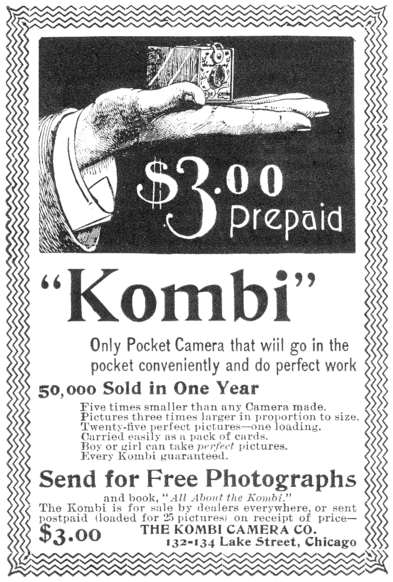The Kombi
Kemper, Alfred C.
| Name: | The Kombi |
| Manufacturer: | Kemper, Alfred C. |
| Country of Origin: | USA |
| Construction: | A small metal box camera of seamless metal construction with oxidised silver finish. The back detaches to load the film. However the camera can also be adapted to act as a viewer for the transparency film. |
| Production Period: | 1892 - ? |
| Plate / Film Size: | Rollfilm, made specially by Kodak, 1⅛" round or square, 25 exposures |
| Lens: | Simple non-achromatic lens (absent on this example) |
| Shutter: | Simple T & I single speed sector shutter |
| Movements: | None |
| Dimensions (w x h x l): | |
| Date of this Example: | c1893 |
| Serial Number: | Two serial numbers present stamped into the casing adjacent to the winding knobs: rear half is 12007; the front half has 5760. Mismatched halves? |
| Availability: |
|
| Inventory Number: | 58 |
<Photographs to be added>
Description
 |
|
 |
The Kombi is a novel miniature box camera first introduced in 1892. Adverts dating to 1894 claim "50,000 sold in one year". The same statement is made on an advert dating to 1896 (see left). As well as taking photographs 1⅛" in size, the unit doubled as a viewer for the developed transparent film. If the pictures were developed into positive transparencies they could then be wound through on the film rollers and viewed through the camera lens, having removed the circular rear panel to illuminate the film. The film was produced by Eastman Kodak specifically for this camera - one of the few instances where Kodak produced film for a camera that was not made by them. The front of the camera carries the name and identifies it as "a combined camera and graphoscope". This example retains its original black box, with "The Kombi" just visible on the top. The box is in good condition, but with some bangs and scuffs, particularly on the corners. |
Notes
It is not uncommon to find these cameras with their original boxes and the metal finish is often in better condition in such cases. A word of warning - don't be in too much of a hurry to try and clean the metalwork as you may end up losing the all important stripes in the factory oxidised metal finish!
They were made in large numbers (probably several hundred thousand) and turn up for sale fairly often in the US and occasionally in Europe. This example was purchased some years ago in the UK.
My example has lost its lens (missing when I bought it). This can happen all too easily if the front cap is removed, so beware. I have seen a number of other examples since that have suffered a similar fate.
![[ ]](../../images/unchecked.png)
![[x]](../../images/checked.png)